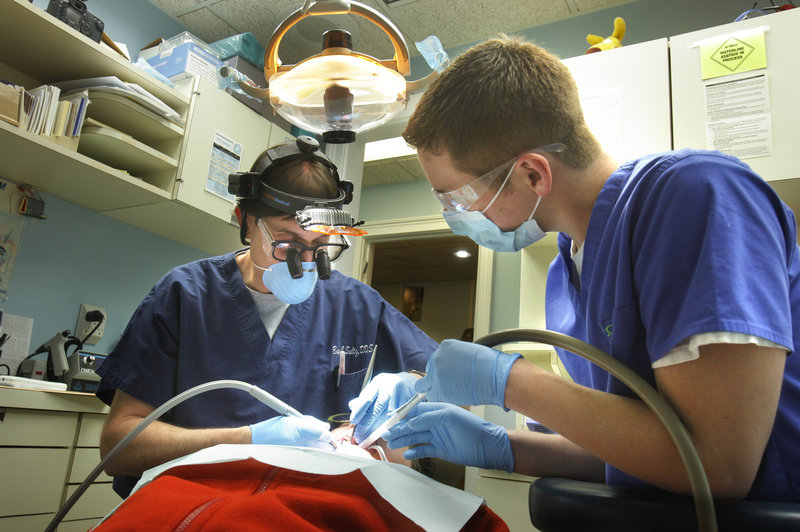Avoidable dental problems were responsible for a growing number of emergency room visits nationwide in 2009, rising 16 percent from 2006, when dental disease was the leading reason for visits by low-income and uninsured young people in Maine, according to a report released Monday by the Pew Center on the States.
Modest investments in improving access to preventive care can reduce emergency room visits and the costs associated with them, the report says. But a shortage of dentists in some areas, and the fact that many dentists don’t accept patients on Medicaid, remain major obstacles.
Maine is making progress in reducing expensive hospital treatment for dental ailments, experts say. Partnerships between hospitals and dental clinics are providing new options. And the University of New England’s plan to open its College of Dental Medicine next fall in Portland – the first dental school in northern New England – will improve access to oral care.
“But it continues to be a significant problem,” said Jeff Austin, a lobbyist for the Maine Hospital Association. “An emergency room is not a good place to get dental care. We don’t have dentists.”
The association doesn’t keep statistics on dental-related visits, Austin said. While anecdotal evidence and efforts for hospitals and dentists to work together are encouraging, the economic downturn has made it harder for residents to afford preventive dental care, he said.
The Pew report calculated that dental conditions were the primary reason for 830,590 emergency room visits nationwide in 2009. The cost of dental treatment in hospitals is very high, exceeding $88 million in Florida in 2010, for instance.
The center is a division of The Pew Charitable Trusts, a nonprofit public policy institution.
In the report, Pew cites a 2006 study that found dental disease was the leading reason for emergency room visits in Maine by Medicaid patients and uninsured residents ages 15-24. Abscesses and other problems were responsible for 3,400 visits, according to the study, done by the University of Southern Maine.
Officials say the situation has improved since then, although they are awaiting an upcoming study to confirm it.
“I think things have gotten better, but we don’t have the data to say that,” said John Bastey, a spokesman for the Maine Dental Association.
Bastey cited the growing coordination between hospitals and dentists. For instance: Rumford Hospital refers patients with oral health issues to Community Dental, which has five centers in Maine. Other hospitals, including Franklin Memorial Hospital in Farmington, are planning similar arrangements.
Dr. James Schmidt, a Community Dental director, sees patients referred from MaineGeneral Medical Center in Augusta and its Waterville campus. They tend to be “working poor,” Schmidt said, or covered by public health insurance.
A large percentage get referred to oral surgeons because their problems are too serious to repair. Medicaid pays for extractions, but not preventive care.
“Some of these people haven’t been to a dentist in years,” he said. “Now they’re at a point where their tooth isn’t saveable.”
In Portland, Maine Medical Center has a working relationship with Community Dental. That helps during office hours, but not at night or on weekends, when emergency room volumes tend to be higher.
Dental visits aren’t increasing at Maine’s largest hospital, said Dr. Michael Baumann, interim chief of the emergency medicine department. A review of data on five typical dental complaints since 2008 shows Maine Med handles an average of 155 patients with dental issues a month. That’s 2 percent of all visits, Baumann said.
“It’s flat,” he said. “It’s definitely not trending up for our visits.”
States must focus on preventing tooth decay, the Pew report says.
Maine is making strides in prevention, said Judy Feinstein, director of the oral health program at the Maine Center for Disease Control and Prevention.
The Pew report identified 21 states that put up hurdles to sealant programs for school-age children, such as requiring an exam by a dentist before a hygienist can do the job. Maine hasn’t had that rule in 25 years, Feinstein said.
Fluoridated water supplies also make a big difference, the report says. In Maine, 80 percent of public water is fluoridated, said Feinstein. The problem is, half of all Mainers get their drinking water from private wells or small systems.
Reimbursement also remains a key challenge. Maine has about 650 dentists, and half of them accept patients on MaineCare, the state’s Medicaid program. But some accept only a few patients. MaineCare reimbursement covers only 40 cents of every dollar in operating costs.
That’s the lowest Medicaid reimbursement rate in New England, said Dr. Barry Saltz of Portland, a member of the Greater Portland Dental Society who helps to organize a free dental-care day every year. It will be helpful that UNE’s new dental school will send students on dental rotations around the state, he said, but the question is whether they will leave Maine to pay off big school loans when they graduate.
“You want to attract younger dentists to the state,” Saltz said. “For them to stay here and see MaineCare patients, we need to get that reimbursement number up.”
Staff Writer Tux Turkel can be contacted at 791-6462 or at:
tturkel@pressherald.com
Correction: The caption for the accompanying photo was revised at 10:47 a.m., Feb. 28, 2012, to state that the University of New England’s new dental school will open in the fall of 2013.
Send questions/comments to the editors.




Comments are no longer available on this story